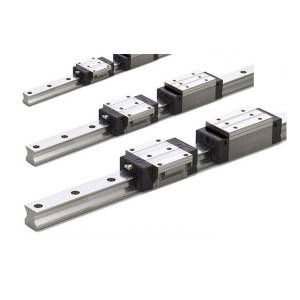The field of robotics has grown exponentially over the past few decades, driven by advancements in automation, artificial intelligence, and manufacturing technologies. Among the many components that enable robots to perform precise, complex tasks is the linear bearing. Linear bearings are a critical part of the mechanical systems in robots, allowing for smooth, accurate movement with minimal friction. As robotics continues to evolve across industries such as manufacturing, healthcare, logistics, and aerospace, the demand for high-quality linear bearings has increased significantly.
At Xinri Bearing, we specialize in the production of high-performance linear bearings that are designed to meet the rigorous demands of the robotics industry. In this article, we will explore the essential role linear bearings play in robotics, their key advantages, and how they contribute to the successful application of robotics across various industries.
What Are Linear Bearings?
Linear bearings are mechanical devices that facilitate smooth, low-friction movement along a linear axis. They are designed to reduce friction between moving parts, allowing for precise motion in one direction. Linear bearings are typically used in conjunction with linear shafts or guide rails, which provide the path along which the bearing moves. These bearings are available in a variety of materials, such as steel, plastic, or ceramic, depending on the specific requirements of the application.
In robotics, linear bearings are commonly used to enable precise movements in tasks such as pick-and-place operations, welding, assembly, and packaging. The ability to control motion accurately and consistently is critical in robots, especially in applications that demand high precision and speed.

The Importance of Linear Bearings in Robotics
Linear bearings play a pivotal role in the performance and functionality of robots. From industrial automation to healthcare robotics, these bearings help robots achieve high levels of efficiency, accuracy, and durability. Here are some of the key reasons why linear bearings are essential in the robotics industry:
1. Smooth and Precise Movement
One of the most important functions of linear bearings is to ensure smooth and precise movement along a linear path. Robots are often required to perform tasks that demand exact positioning, such as in manufacturing lines where components must be assembled or manipulated with extreme precision. Linear bearings minimize friction between moving parts, allowing the robot to move smoothly and accurately.
For instance, in robotic arms used for material handling or assembly, linear bearings provide the stability and precision required to move parts without errors or delays. At Xinri Bearing , our linear bearings are designed to offer exceptional accuracy and repeatability, ensuring that robots can consistently perform tasks with the highest level of precision.
2. Load-Bearing Capacity
In many industrial and commercial robotics applications, robots are required to carry or move heavy loads. Whether it’s handling components in a factory or lifting materials in a warehouse, the ability to support weight while maintaining smooth motion is crucial. Linear bearings are designed to handle heavy loads while minimizing resistance, ensuring that the robot can move efficiently even under significant weight.
Our Xinri Bearing linear bearings are engineered with high load-bearing capacities, making them suitable for use in applications where robots must manage large or heavy objects. This capability is essential for ensuring the longevity and reliability of robotic systems, even in demanding environments.
3. Reduced Wear and Tear
Robots operating in industrial environments are subject to continuous use, often running for hours or even days at a time without interruption. In such conditions, reducing wear and tear on components is critical to maintaining performance and minimizing downtime. Linear bearings are designed to provide long-lasting durability by reducing friction between moving parts, which helps prevent wear over time.
By using high-quality materials and precision engineering, Xinri Bearing ensures that our linear bearings offer extended service life, reducing the need for frequent maintenance or replacement. This durability is essential for maintaining the efficiency of robotic systems in industries where downtime can be costly.
4. High-Speed Operation
In many robotics applications, speed is just as important as precision. Robots are often required to complete tasks quickly, whether in assembly lines, warehouses, or medical applications. Linear bearings enable high-speed motion without sacrificing accuracy or stability. This is particularly important in industries like electronics manufacturing, where fast, precise movements are essential for assembling small components.
Our linear bearings at Xinri Bearing are designed to operate at high speeds with minimal friction, ensuring that robots can perform tasks quickly and efficiently without compromising on quality.
5. Flexibility and Adaptability
Robots are used in a wide range of industries, each with its own unique set of requirements. From healthcare to aerospace, different applications demand different levels of precision, load capacity, and speed. Linear bearings offer the flexibility to adapt to various tasks, making them ideal for use in diverse robotics applications.
At Xinri Bearing, we offer a variety of linear bearing solutions tailored to specific industries and applications, ensuring that our bearings can meet the unique needs of any robotic system. Whether you need bearings for a lightweight medical robot or a heavy-duty industrial machine, our products provide the flexibility and adaptability required to ensure optimal performance.

Applications of Linear Bearings in Robotics
The versatility of linear bearings makes them an essential component in many types of robotic systems. Here are some key applications of linear bearings in the robotics industry:
1. Industrial Automation
In industrial settings, robots are used for tasks such as assembly, welding, painting, and material handling. Linear bearings are critical in ensuring that these robots can move smoothly and efficiently along production lines. By enabling precise linear motion, linear bearings help robots achieve high levels of productivity and accuracy, making them indispensable in automation systems.
2. Healthcare Robotics
The use of robots in healthcare is rapidly expanding, from surgical robots to rehabilitation devices. In these applications, precision and stability are critical. Linear bearings are used in robotic surgical arms to provide smooth, accurate motion during delicate procedures. Similarly, in robotic exoskeletons or prosthetics, linear bearings ensure precise control and movement for patients.
3. Logistics and Warehousing
Robots are increasingly being used in logistics and warehousing for tasks such as sorting, picking, and transporting goods. Linear bearings play a key role in enabling robots to move quickly and efficiently across warehouse floors or conveyor systems, helping businesses streamline operations and improve productivity.
4. Aerospace and Defense
In the aerospace and defense sectors, robots are used for tasks such as assembly, inspection, and maintenance of aircraft and other machinery. These applications demand high levels of precision and durability, and linear bearings ensure that robotic systems can perform reliably in such demanding environments.

Conclusion
Linear bearings are an essential component in the robotics industry, enabling precise, smooth, and efficient motion for a wide range of robotic systems. Whether in industrial automation, healthcare, or aerospace, linear bearings play a critical role in enhancing the performance and reliability of robots. At Xinri Bearing, we are committed to providing high-quality linear bearings that meet the specific demands of the robotics industry, ensuring that robots can operate with precision, speed, and durability.
By choosing Xinri Bearing , you are investing in the future of robotics, supported by components that are built to withstand the challenges of modern technology.
By Xinri Bearing
Post time: Sep-10-2024
